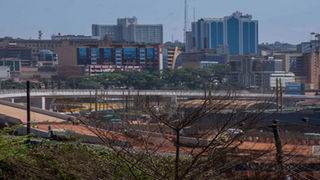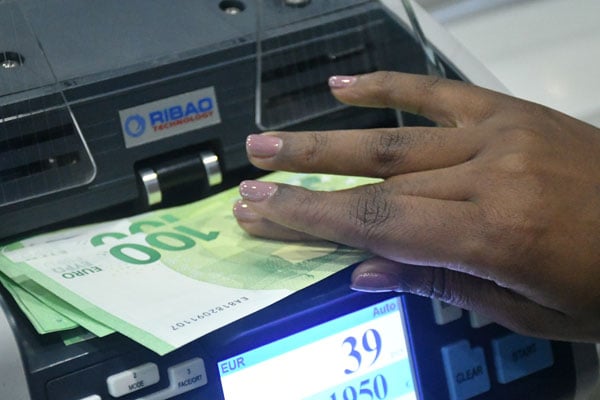
Part of the Kampala Flyover under construction. PHOTO/ ISAAC KASAMANI
|Prosper
Prime
Is Uganda’s public debt hurting private sector investment?
What you need to know:
As Uganda’s public debt rises to Shs80 trillion, private investment is declining because government is borrowing to pay back debts.
Despite government’s position that public debt is still within manageable range, it has emerged that the country is just one shock away from slipping into the high risk category.
Following the country’s graduation from Low Risk of Debt Distress to the category of Moderate Risk of Debt Distress, economists, researchers, policy analysts and civil society organizations now believe that the government is already treading on slippery grounds.
Due to the above risks, the country’s policy and economic managers should stay warned and should never consider resting on their laurels, assuming all is under control.
While public debt is projected to surpass the 50 per cent threshold in the next financial year, Ministry of Finance Permanent Secretary and Secretary to The Treasury, Mr Ramathan Ggoobi, maintains that debt levels remain manageable and below the levels of (those in) most countries in the region.
Even as the government confidently states that there is no reason for alarm, the same cannot be said about the effect of public borrowing on private credit and investment.
According to a study titled: How Sustainable Is the Public Debt for Uganda, presented during the annual debt and development policy dialogue by Economists Dr Fred Muhumuza from Makerere School of Economics and Mr Paul Wabiga from MUBS Economics Forum, it became clear that the increasing rate of debt is higher than the rate of increment in the GDP levels.
This means return on investment resulting from public borrowing is not creating enough economic activities to generate revenues to pay back the debt, creating a risk of reaching the unsustainable levels sooner than later.

Cars use a section of a road under constructon. At least Shs6.1 trillion will go to interest payments in the FY2023/24. PHOTO/ ISAAC KASAMANI
“This has begun to translate into higher cost of borrowing which may deny future generations the opportunity to sustainably borrow,” Dr Muhumuza told the audience following the Ministry of Finance, CSBAG, MUBS and NTV sponsored dialogue.
The two researchers argued that the focus should be paid to the proportion of government revenue, which is nearly 30 percent that goes into servicing interest costs.
According to CSBAG executive director, Mr Julius Mukunda, despite an increase from Shs47 trillion to Shs50 trillion in the next Financial Year 2023/24 budget, discretionary amounts have reduced by Shs3 trillion, something he said undermines government’s ability to take charge of the budget in terms of focusing on key sectors of the economy.
Dim investment image
In the 1990s, the multilateral creditors provided debt a relief under the HIPC initiative equivalent to about $650 million. In 2005, under MDRI, close to 100 per cent of the debt was cancelled. Following MDRI debt cancellation, Uganda’s debt stock reduced by 65 per cent.
But from 2005, the stock of public debt has been rising rapidly and triggering a range of negative results and risks hence the current concerns and debate. Rising debt has been driven by ambitious targets enshrined in both NDPs and Vision 2040, targeting to transform the economy from a peasant one to a monetised lower middle-income country.
To achieve the above, the private sector has been recognised as the engine to propel growth and economic transformation.
“But as debt rises, we notice private investment starting to decline instead,” economist and researcher, Mr Wabiga noted in his presentation.
According to the expert analysis, public debt is one of the key determinants of the availability of capital to private enterprises, but for Uganda’s case, this does not seem to be ‘the obvious case’.
For example in 2018/19, government borrowed Shs7.3 billion from the domestic market, comprised of Shs2.1 billion for budget support and Shs5.2 billion for refinancing maturing obligations. However, servicing of the principal and interest for the domestic debt accounted for Shs7.2 billion.
“This implies that servicing maturing obligations and interest accounted for 97 per cent of the new money borrowed,” the analysis presented by the duo reveals.
“In essence, we borrow to pay debts, which is likely to raise the dependence of government on the domestic market which may lead to an increase in interest rates – undermine private sector,” reads part of the study.
Also, Fitch credit rating Agency June 2020 revised Uganda’s Issuer Default Rating (IDR) outlook from stable to negative on account of the decrease in revenue sources and the coronavirus shock amid a continued build-up of government public debt.
This and all other international recognised ratings have an effect on investment as it dims the image of the country as an unconducive investment destination.
Domestic arrears
The perpetual government default to pay local suppliers is still an issue as public debt stock continues piling up. Accounting officers do not make sufficient budget provisions towards the settlement of domestic arrears on the account of insufficient funds. Year in, year out, domestic arrears continue to pile as debt servicing consumes a huge share of the national budget. This cripples the ability of domestic business and investment to grow.
In terms of incentives and exemptions, there is no clear policy guideline for the issuance, management and monitoring of the different tax benefits and incentives issued by the government to different beneficiaries.
All these foregone revenues could have reduced the need for borrowing, including minimising competition for private sector capital that is consumed by government in the domestic market, crowding out private sector from accessing capital from banks.

Cars use part of the Kampala-Entebbe Expressway. The return on investment resulting from public borrowing is not creating enough economic activities that can generate revenues to pay back the country’s debt. PHOTO/ISAAC KASAMANI
CSOs weigh in
In his remarks, Mr Mukunda urged the government to look beyond debt to Gross Domestic Product measures in gauging the public debt levels and performance. For example, domestic interest servicing to domestic revenue excluding grants as of financial year 2021/22 stood at 24.1 per cent which is above the set benchmark of 12.5 per cent while the ratio of total debt service to total government expenditure is at 19.1 percent which is greater than the Public Debt Management Framework (PDMF) benchmark of 10 per cent – all of which are valuable measures.
The need for debt planning, according to the CSBAG executive director, should be of utmost importance.
“We note that Uganda has been contracting debt to finance its budget and development agenda. However, the main challenge remains the absence of a clear debt plan to guide when, where, and how debt has been negotiated and acquired. The absence of such a plan has resulted in poor absorption of contracted [government] debt which continues to attract high commitment fees and affects service delivery. For example, as of 2022, undisbursed loans stood at Shs15.6 trillion,” he explained.
Going forward, Mr Mukunda recommended cancellation of non-performing debts /contracts.
He also recommends that definition of public debt, saying it has been a grey area that has not been discussed and agreed upon by many stakeholders.
Currently, while computing the public debt stock, the government does not consider domestic areas and the money it owes the Bank of Uganda. For example, the current stock of domestic arrears increased from Shs4.65 trillion in 2021 to Shs7.55 trillion in 2022.
Economic manager
According to Mr Ggoobi, there is no doubt Ugandan economy has shown resilience in the face of strong external and internal headwinds. He notes that Public debt remains sustainable in the medium to long term, despite declining risk rating from ‘Low’ to ‘Moderate’.
The country’s debt/GDP ratio, he says, remains one of the lowest in the region, and is projected to decline in the medium term. Although there has been an increase in expensive external commercial and domestic borrowing, he said government is taking steps to address this.
“Government will pursue a strategy of fiscal consolidation in the medium term, underpinned by improved revenue mobilisation and reduction in less productive expenditure,” he told the audience attending the Dialogue on Debt and Development under the Theme: “How Sustainable is the Public Debt for Uganda?”
The debate about debt comes at a time when Uganda’s debt portfolio has tremendously risen.
As of October 2022, public debt in nominal value stood at Shs79.9 trillion, according to Ministry of Finance data.




